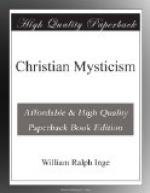[Footnote 266: Tauler adheres to the doctrine of an “uncreated ground,” but he holds that it must always act upon us through the medium of the “created ground.” He evidently considered Eckhart’s later doctrine as too pantheistic. See below, p. 183.]
[Footnote 267: See p. 155. In my estimate of Tauler’s doctrine, I have made no use of the treatise on The Imitation of the Poverty of Christ, which Noack calls his masterpiece, and the kernel of his Mysticism. The work is not by Tauler.]
[Footnote 268: See above, p. 170.]
[Footnote 269: This expression is found first, I think, in Richard of St. Victor; but St. Augustine speaks of “oculus interior atque intelligibilis” (De div. quaest. 46).]
[Footnote 270: But Christ, he says, could see with both eyes at once; the left in no way hindered the right.]
[Footnote 271: Tauler often uses similar language; as, for instance, when he says, “The natural light of the reason must be entirely brought to nothing, if God is to enter with His light.”]
[Footnote 272: Stoeckl criticises the Theologia Germanica in a very hostile spirit. He finds it in “pantheism,” by which he means acosmism, and also “Gnostic-Manichean dualism,” the latter being his favourite charge against the Lutherans and their forerunners. He considers that this latter tendency is more strongly marked in the German Theology than in the other works of the Eckhartian school, in that the writer identifies “the false light” with the light of nature, and selfhood with sin; “devil, sin, Adam, old man, disobedience, selfhood, individuality, mine, me, nature, self-will, are all the same; they all represent what is against God and without God.” Accordingly, salvation consists in annihilation of the self, and substitution for God for it. There is no doubt that the writer of this treatise is deeply impressed with the belief that the root of sin is self-will, and that the new birth must be a complete transformation; but it must be remembered that the language of piety is less guarded than that of dogmatic disputation, and that the theology of such a book must be judged by its whole tendency. My own judgment is that, taken as a whole, it is safer than Tauler or Ruysbroek, and much safer than Eckhart. The strongly-marked “ethical dualism” is of very much the same kind as that which we find in St. John’s Gospel. Taken as a theory of the origin and nature of evil, it no doubt does hold out a hand to Manicheism; but I do not think that the writer meant it to be so taken, any more than St. John did.]
[Footnote 273: Throughout the fourteenth century, and still more in the fifteenth, we can trace an increasing prominence given to subjugation of the will in mystical theology. This change is to be attributed partly to the influence of the Nominalist science of Duns Scotus, which gradually gained (at least this point) the ascendancy over the school of Aquinas. It may be escribed as a transition from the more speculative Mysticism towards quietism. In the fourteenth century writings, such as the Theologia Germanica, we merely welcome a new and valuable aspect of the religious life; since the change is connected with a distrust of reason, and a return to standpoint of harsh legalism, we cannot regard it as an improvement.]




